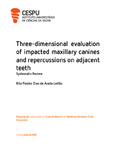| dc.contributor.advisor | PINHO, TERESA MARIA DA COSTA | |
| dc.contributor.author | Leitão, Rita Pombo Dias de Arada | |
| dc.date.accessioned | 2023-11-24T14:27:48Z | |
| dc.date.available | 2023-11-24T14:27:48Z | |
| dc.date.issued | 2023 | |
| dc.identifier.uri | http://hdl.handle.net/20.500.11816/4483 | |
| dc.description.abstract | Introdução: Os caninos maxilares (MC) apresentam um papel fundamental na estética e função. Considerados o segundo dente mais frequentemente incluso. A reabsorção radicular (RR) dos dentes adjacentes é uma das complicações que lhes está associada. A tomografia computorizada de feixe cónico (CBCT) permite obter imagens multiplanares tridimensionais e informações de estruturas dentofaciais para localização precisa do canino maxilar incluso (IMC) e determinação da reabsorção radicular (RR) nos dentes adjacentes.
Objectivo: Localizar o IMC tridimensionalmente, determinando a posição mais frequente e analisando a RR nos dentes adjacentes causada pela inclusão, recorrendo ao CBCT.
Materiais e métodos: A metodologia PRISMA foi aplicada, sendo realizada uma pesquisa bibliográfica dos últimos 11 anos nas plataformas PubMed e Scielo utilizando as palavras-chave “Cone-beam computed tomography”, “Maxilla”, “Cuspid”, “Root Resorption”, “Tooth, impacted”. Esta pesquisa foi conduzida através de critérios de inclusão e exclusão.
Resultados: Os incisivos laterais (LI) foram mais afetados pela RR, especialmente com dimensões de coroa, comprimento e volume da raiz reduzidas. Prevalência do sexo feminino, embora controverso.
Discussão: Alguns autores constataram que a localização por palatino do IMC é mais frequente. Uma relação estatisticamente significativa entre IMC bilateral e elevado número de RR foi referida, contudo o grau desta não é concordante entre autores.
Conclusão: O CBCT fornece medições precisas de parâmetros angulares, lineares e reabsorção. IMC posiciona-se frequentemente por palatino, mesializado e horizontal. Dentes adjacentes para além da superfície mesial, associados a caninos palatizados, que a ponta da cúspide destes se encontra no terço apical das suas raízes são suscetíveis a RR. | pt_PT |
| dc.description.abstract | Introduction: Maxillary canines (MC) have very important roles in aesthetics and function. They're the second most frequently impacted teeth. One of the most severe complications associated with impacted maxillary canines (IMC) is root resorption (RR) of adjacent teeth. Cone-beam computed tomography (CBCT) provides three-dimensional multiplanar images and detailed information on dentofacial structures for more precise localization of IMC and determination of RR In adjacent teeth.
Objective: To localize IMC from three dimensions and analyse RR of the adjacent teeth caused by the Impaction, based only on CBCT.
Materials and methods: The PRISMA methodology was applied, and a literature search of the last 11 years was carried out in PubMed and Scielo using the keywords: “Cone-beam computed tomography”, “Maxilla”, “Cuspid”, “Root Resorption”, “Tooth, impacted”. This search was conducted through inclusion and exclusion criteria.
Results: LI were more affected by RR, especially when the widths of the crown, root length and volume are decreased. Female gender predominates in IMC, however this is controversial.
Discussion: Some authors stated that IMC most common position is palatal. A statistically significant connection between bilaterally IMC and a greater number of teeth's resorption was found, notwithstanding the degree of RR isn't consistent between authors.
Conclusion: CBCT examination provide precise measurements of angular, linear, and resorption parameters. IMC frequent location is palatal, mesial and horizontal. Adjacent teeth located beyond the mesial surface, in contact with PIC that the cusp tip of the canine is at the apical third of their roots were likely to suffer RR. | pt_PT |
| dc.language.iso | eng | pt_PT |
| dc.rights | info:eu-repo/semantics/openAccess | pt_PT |
| dc.subject | Cone-beam computed tomography | pt_PT |
| dc.subject | Maxilla | pt_PT |
| dc.subject | Cuspid | pt_PT |
| dc.subject | Root Resorption | pt_PT |
| dc.subject | Tooth impacted | pt_PT |
| dc.title | Three-dimensional evaluation of impacted maxillary canines and repercussions on adjacent teeth Systematic Review | pt_PT |
| dc.type | info:eu-repo/semantics/masterThesis | pt_PT |
| dc.identifier.tid | 203357132 | pt_PT |
| thesis.degree.name | Mestrado em Medicina Dentária | pt_PT |

